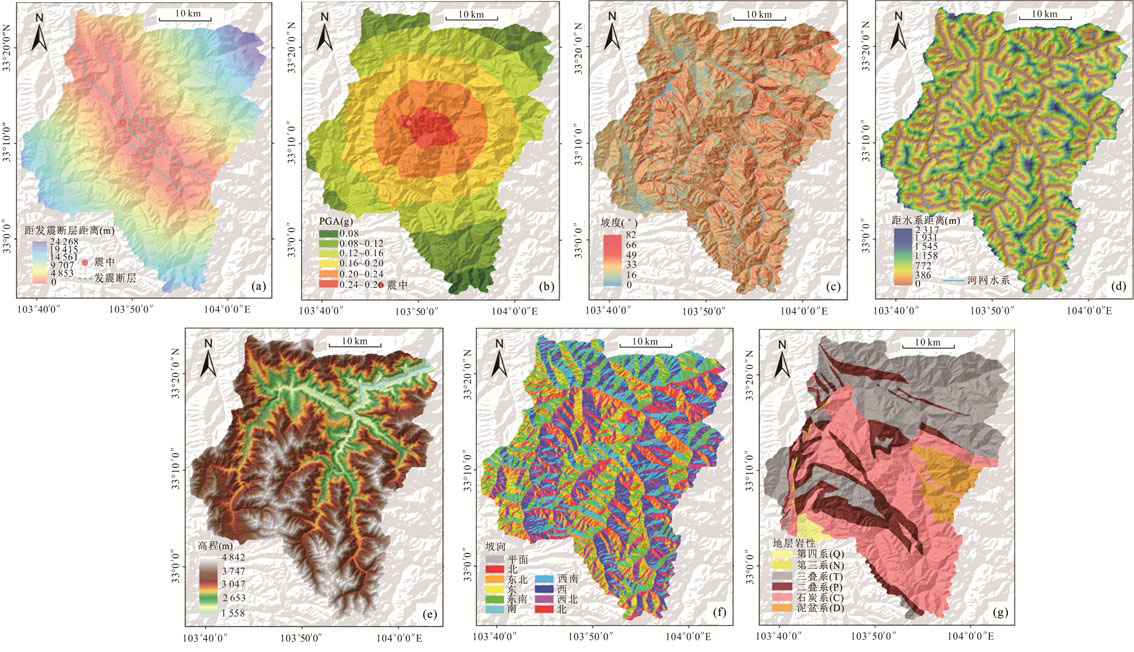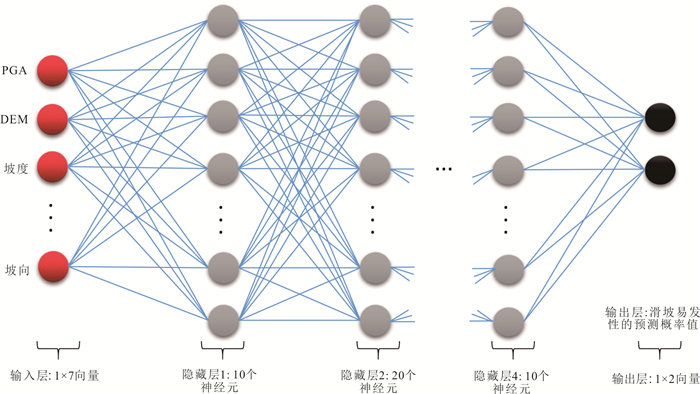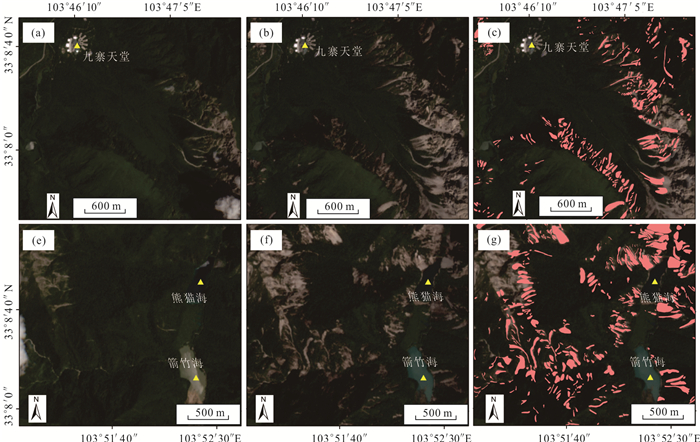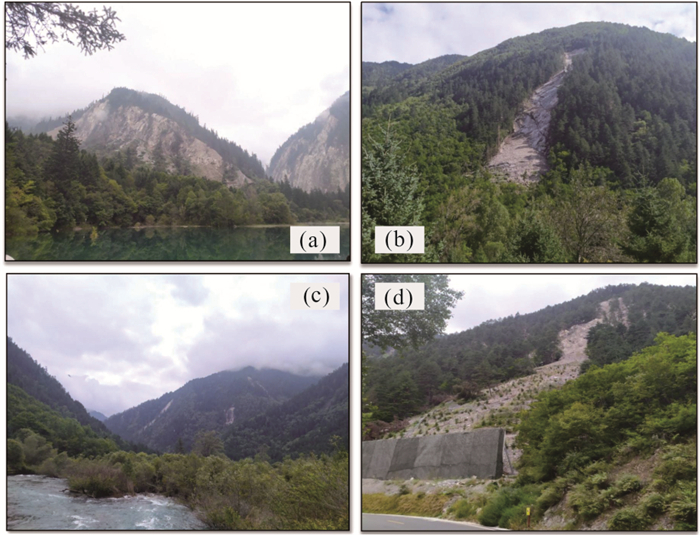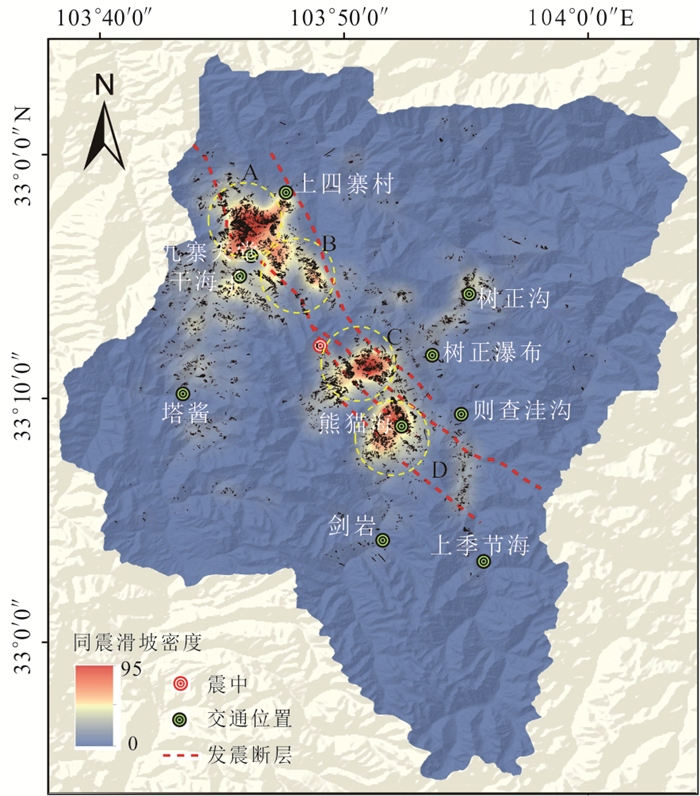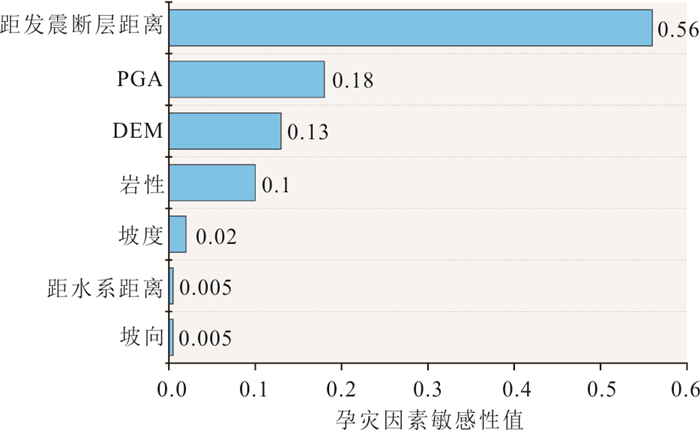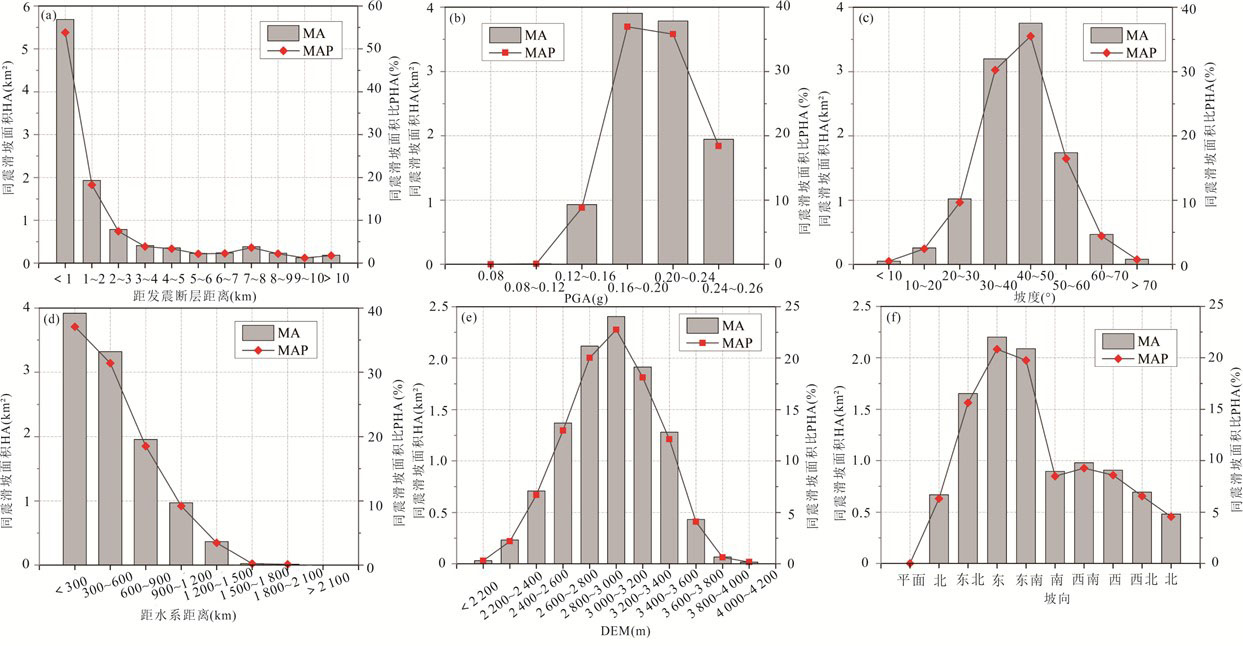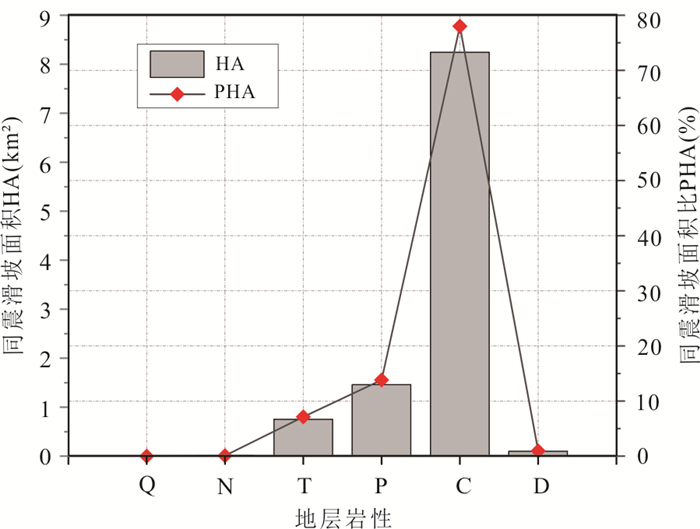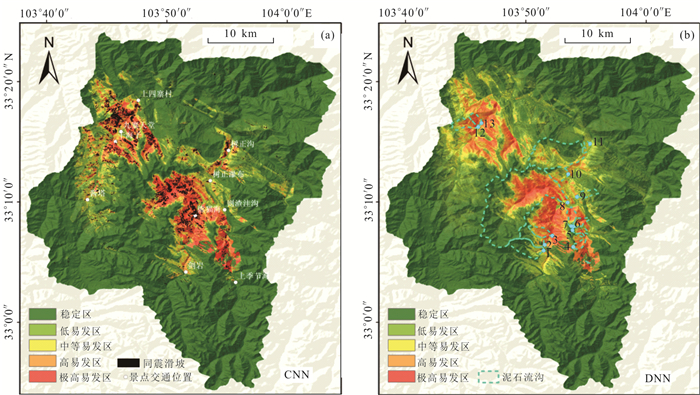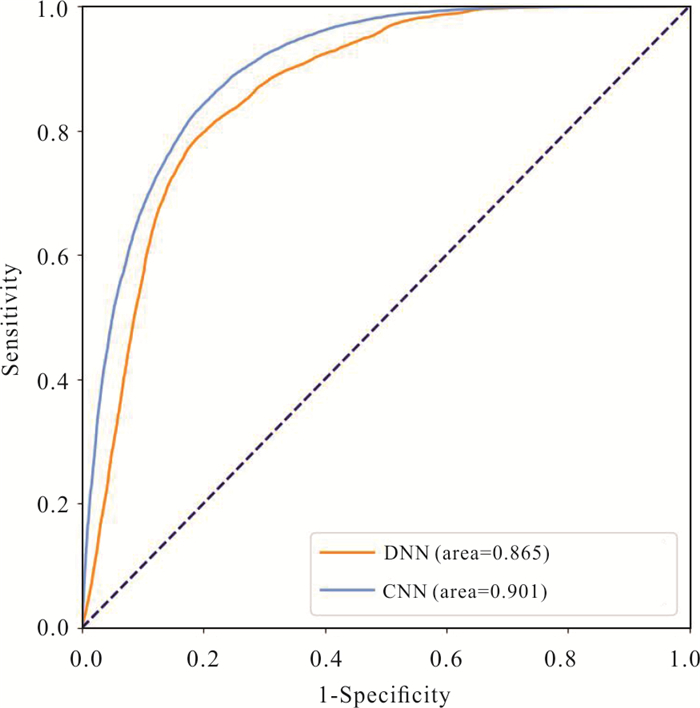Study on Development Patterns and Susceptibility Evaluation of Coseismic Landslides within Mountainous Regions Influenced by Strong Earthquakes
-
摘要: 强震山区地形陡峭,植被茂盛,使同震滑坡“点多面广”,难以探测,为灾害防控带来困难.滑坡易发性评估能够预测灾害空间分布.但传统评估方法存在数据源有限、数据量化标准不一等问题,难以获取准确的易发性评价结果及难以掌握复杂孕灾环境下滑坡发育特征.鉴于此,通过多源监测数据、空间分析和深度学习方法,分析同震滑坡的发育规律,探究滑坡的地震响应机制,并进行滑坡易发性区划.结果表明:地震通过影响地形地貌的应力场及岩土体结构对地震波的地震响应的作用,使同震滑坡表现不同形式的发灾效应(如锁固段效应、微地形效应和地层倾向效应等);采用基于卷积神经网络(CNN)和深度神经网络(DNN)的深度学习模型取得了良好的易发性评价结果(AUC值分别为0.901和0.865),CNN模型的预测性能优于DNN模型.两模型精度都较高,均能较为准确识别潜在的滑坡区域;极高和高滑坡易发性区域广泛分布于丹祖沟等13条沟道中,这些沟道在暴雨下更容易发生泥石流.Abstract: Coseismic landslides are imperceptible and widely distributed in the mountainous regions with abundant vegetation influenced by strong earthquakes, which hinders the development of prevention and control for disaster. Landslide susceptibility evaluation can predict the landslide-prone areas. But few studies have obtained the high-precision landslide susceptibility maps, and it was difficult to uncover the patterns of coseismic landslides under the complex geo-environment, because the lack of data and there was no unified standards for quantification of data based on traditional landslide susceptibility evaluation method. Therefore, the multi-source monitoring data, spatial analysis and deep learning method were adopted in this work to find out the development patterns, seismic response mechanism of landslide and to obtain landslide susceptibility maps. The main conclusions are as follows: the seismic response mechanism of landslide was proposed based on the seismic response analysis of landform and rock structure. The CNN (convolutional neural network) and DNN (deep neural network) achieved the relatively good area under the curve (AUC) value (AUC were 0.901 and 0.865, respectively), which could obtain the high-precision landslide susceptibility maps. Extremely high and high susceptibility region of landslides were widely distributed in 13 gullies, such as Danzu gully and so on. And these gullies were more prone to debris flow under rainstorm.
-
Key words:
- development pattern /
- deep learning /
- landslide susceptibility /
- disaster effect /
- hazard geology
-
表 1 遥感影像和地理数据
Table 1. Remote sensing image and geographic information data
数据类型 数据来源 日期 分辨率 遥感影像 Sentinel-2A 20170729 10 m 20170907 10 m Google image 20151207 0.3 m 20170814 0.3 m 地震数据 美国地质调查局 20170808 矢量数据 中国地震局 20170808 矢量数据 地质数据 中国地质调查局 震前 1∶200 000 地形数据 美国航空航天局 20110213 12.5 表 2 同震滑坡面积占各易发性区域的百分比
Table 2. Percentage of coseismic landslides in the susceptibility region
DNN CNN 滑坡占极高易发区(%) 64.71 77.33 滑坡占高易发区(%) 20.26 11.45 滑坡占中等易发区(%) 6.79 5.15 滑坡占低易发区(%) 3.70 2.74 滑坡占稳定区(%) 4.54 3.33 表 3 2017年九寨沟地震诱发滑坡相关研究对比结果
Table 3. Comparison of relevant studies on landslides triggered by the 2017 Jiuzhaigou earthquake
研究区面积(km2) 同震滑坡面积(km2) 滑坡数量(个) 滑坡最大面积(104m2) 最小面积(m2) 遥感影像数据源 戴岚欣等(2017)、Fan et al. (2018) 840 8.11 1 883 23.1 9.7 SPOT5(2.5 m)、UAV(0.2 m)、GF-1、GF-2(1 m) 许冲等(2018) / 9.6 4 800 / / GF-1与GF-2(0.8~2 m)、Google image(0.5 m) Wang et al. (2018) 651.3 11.8 2 212 20.9 10 Google image(1 m)、GF-2(4 m)、Sentinel-2A(10 m)、UAV Wu et al. (2018) 1 275 11.8 2 122 23.1 9.7 Google image(1 m)、GF-2(4 m)、Sentinel-2A(10 m)、UAV Tian et al. (2019) 434 9.64 4 834 23.6 7.8 Google image(0.5 m) Yi et al. (2020) 546.85 / 681 20.0 80 Sentinel-2A(10 m)、GF-1(2 m)、GF-2(1 m) Ling et al. (2021) 1 840 14.1 5 633 23.9 15 Google image(0.5 m)、GF-2(1 m)、UAV(0.2 m)、Sentinel-2A(10 m) Wang and Mao (2022) 938.9 9.45 5 431 24.3 6 Google image(0.3 m)、GF-1、GF-2(2 m)、Sentinel-2A(10 m)、Planet image(3m) 本研究 1 330 10.56 5 487 24.3 5.5 Google image(0.3 m)、Sentinel-2A(10 m) 注:UAV为Unmanned Aerial Vehicle images无人机影像; GF⁃1和GF⁃2分别为高分1号和2号影像. -
Chang, M., Cui, P., Xu, L., et al., 2021. The Spatial Distribution Characteristics of Coseismic Landslides Triggered by the Ms7.0 Lushan Earthquake and Ms7.0 Jiuzhaigou Earthquake in Southwest China. Environmental Science and Pollution Research, 28(16): 20549-20569. https://doi.org/10.1007/s11356-020-11826-5 Chang, M., Tang, C., Jiang, Z.L., et al., 2014. Dynamic Evolution Process of Sediment Supply for Debris Flow Occurrence in Longchi of Dujiangyan, Wenchuan Earthquake Area. Journal of Mountain Science, 32(1): 89-97 (in Chinese with English abstract). http://search.cnki.net/down/default.aspx?filename=SDYA201401014&dbcode=CJFD&year=2014&dflag=pdfdown Chen, X., Shan, X., Wang, M., et al., 2020. Distribution Pattern of Coseismic Landslides Triggered by the 2017 Jiuzhaigou Ms 7.0 Earthquake of China: Control of Seismic Landslide Susceptibility. ISPRS International Journal of Geo-Information, 9(4): 198. https://doi.org/10.3390/ijgi9040198 Chen, X. L., Yuan, R. M., Yu, L., 2013. Applying the Newmark's Model to the Assessment of Earthquake-Triggered Landslides during the Lushan Earthquake. Seismology and Geology, 35(3): 661-670 (in Chinese with English abstract). Cui, P., Chen, X., Zhu, Y., et al., 2011. The Wenchuan Earthquake (May 12, 2008), Sichuan Province, China, and Resulting Geohazards. Natural Hazards, 56(1): 19-36. https://doi.org/10.1007/s11069-009-9392-1 Cui, P., Zhuang, J. Q., Chen, X. C., et al., 2010. Characteristics and Countermeasures of Debris Flow in Wenchuan Area after the Earthquake. Journal of Sichuan University (Engineering Science Edition), 42(5): 10-19 (in Chinese with English abstract). Dai, C., Li, W., Wang, D., et al., 2021. Active Landslide Detection Based on Sentinel-1 Data and InSAR Technology in Zhouqu County, Gansu Province, Northwest China. Journal of Earth Science, 32(5): 1092. doi: 10.1007/s12583-020-1380-0 Dai, L. X., Xu, Q., Fan, X. M., et al., 2017. A Preliminary Study on Spatial Distribution Patterns of Landslides Triggered by Jiuzhaigou Earthquake in Sichuan on August 8th, 2017 and Their Susceptibility Assessment. Journal of Engineering Geology, 25(4): 1151-1164 (in Chinese with English abstract). http://en.cnki.com.cn/Article_en/CJFDTOTAL-GCDZ201704030.htm Delen, D., Tomak, L., Topuz, K., et al. ., 2017. Investigating Injury Severity Risk Factors in Automobile Crashes with Predictive Analytics and Sensitivity Analysis Methods. Journal of Transport & Health, 4: 118-131. https://doi.org/10.1016/j.jth.2017.01.009 Fan, X., Scaringi, G., Xu, Q., et al., 2018. Coseismic Landslides Triggered by the 8th August 2017 Ms 7.0 Jiuzhaigou Earthquake (Sichuan, China): Factors Controlling Their Spatial Distribution and Implications for the Seismogenic Blind Fault Identification. Landslides, 15(5): 967-983. https://doi.org/10.1007/s10346-018-0960-x Fan, Z. Y., Gou, X. F., Qin, M. Y., et al., 2018. Information and Logistic Regression Models Based Coupling Analysis for Susceptibility of Geological Hazards. Journal of Engineering Geology, 26(2): 340-347 (in Chinese with English abstract). http://en.cnki.com.cn/Article_en/CJFDTotal-GCDZ201802008.htm Feng, S., Zhou, H., Dong, H., 2019. Using Deep Neural Network with Small Dataset to Predict Material Defects. Materials & Design, 162: 300-310. https://doi.org/10.1016/j.matdes.2018.11.060 Feng, W.K., Yang, Q., Yang, X., et al., 2018. Study of Disaster Effect and Disaster Mitigation Model of Zemuhe Fault Zone. Journal of Engineering Geology, 26(4): 939-950 (in Chinese with English abstract). http://search.cnki.net/down/default.aspx?filename=GCDZ201804014&dbcode=CJFD&year=2018&dflag=pdfdown Guo, Z.Z., Yin, K.L., Fu, S., et al., 2019. Evaluation of Landslide Susceptibility Based on Landslide Classification and Weighted Frequency Ratio Model. Earth Science, 44(12): 4299-4312 (in Chinese with English abstract). http://en.cnki.com.cn/Article_en/CJFDTotal-YSLX201902007.htm Guzzetti, F., Ardizzone, F., Cardinali, M., et al., 2009. Landslide Volumes and Landslide Mobilization Rates in Umbria, Central Italy. Earth and Planetary Science Letters, 279(3-4): 222-229. https://doi.org/10.1016/j.epsl.2009.01.005 Huang, J., Ling, X., 2005. Using AUC and Accuracy in Evaluating Learning Algorithms. IEEE Transactions on Knowledge and Data Engineering, 17(3): 299-310. https://doi.org/10.1109/tkde.2005.50 Huang, R.Q., 1991. Laxiwa Hydropower Station on the Yellow River: Systematic Engineering Geological Study of High Slope Stability. Chengdu University of Science and Technology Press, Chengdu (in Chinese). Huang, W. B., Ding, M. T., Wang, D., et al., 2022. Evaluation of Landslide Susceptibility Based on Layer Adaptive Weighted Convolutional Neural Network Model along Sichuan-Tibet Traffic Corridor. Earth Science, 47(6): 2015-2030 (in Chinese with English abstract). Jiao, Q., Luo, Y., Shen, W., et al., 2018. Rapid Extraction of Landslides and Spatial Distribution Analysis after Jiuzhaigou Ms7.0 Earthquake Based on UAV Images. International Archives of the Photogrammetry, Remote Sensing & Spatial Information Sciences, 42(3): 685-690. http://www.int-arch-photogramm-remote-sens-spatial-inf-sci.net/XLII-3/685/2018/isprs-archives-XLII-3-685-2018.pdf Jibson, R., Harp, E., Schulz, W., et al., 2004. Landslides Triggered by the 2002 Denali Fault, Alaska, Earthquake and the Inferred Nature of the Strong Shaking. Earthquake Spectra, 20(3): 669-691. https://doi.org/10.1193/1.1778173 LeCun, Y., Ranzato, M., 2013. Deep Learning Tutorial. Tutorials in International Conference on Machine Learning (ICML' 13), Hawaii, 1-29. Li, N., Tang, C., Bu, X.H., et al., 2020. Characteristics and Evolution of Debris Flows in Wenchuan County after "5·12" Earthquake. Journal of Engineering Geology, 28(6): 1233-1245 (in Chinese with English abstract). Li, W. B., Fan, X. M., Huang, F. M., et al., 2021. Uncertainties of Landslide Susceptibility Modeling under Different Environmental Factor Connections and Prediction Models. Earth Science, 47(10): 3777-3795 (in Chinese with English abstract). http://www.sciencedirect.com/science/article/pii/S0341816221001090 Li, Y. S., Huang, C., Yi, S. J., et al., 2017. Study on Seismic Fault and Source Rupture Tectonic Dynamic Mechanism of Jiuzhaigou Ms7.0 Earthquake. Journal of Engineering Geology, 25(4): 1141-1150 (in Chinese with English abstract). Liang, J., Pei, X. J., Wen, Y., et al., 2019. Research on Development and Distribution Rules of Geohazards in Jiuzhaigou Earthquake in 2017. Journal of Natural Disasters, 28(5): 181-188 (in Chinese with English abstract). Ling, S., Sun, C., Li, X., et al., 2021. Characterizing the Distribution Pattern and Geologic and Geomorphic Controls on Earthquake-Triggered Landslide Occurrence during the 2017 Ms 7.0 Jiuzhaigou Earthquake, Sichuan, China. Landslides, 18(4): 1275-1291. https://doi.org/10.1007/s10346-020-01573-6 Nguyen, A., Kim, J., Oh, H., et al., 2018. Deep Visual Saliency on Stereoscopic Images. IEEE Transactions on Image Processing, 28(4): 1939-1953. https://doi.org/10.1109/TIP.2018.2879408 Ni, H.Y., Zheng, W.M., Tang, Y.Q., et al., 2011. Mechanism and Characteristics of Wenjia-Gully Debris Flow in Epicenter Area of Wenchuan Earthquake. Journal of Engineering Geology, 19(2): 262-270 (in Chinese with English abstract). http://www.en.cnki.com.cn/Article_en/CJFDTOTAL-GCDZ201102022.htm Shen, T., Wang, Y. S., Luo, Y. H., et al., 2018. Monitoring Result and Analysis of Slope Seismic Response during the Jiuzhaigou MS7.0 Earthquake. Journal of Engineering Geology, 26(6): 1611-1621 (in Chinese with English abstract). http://d.old.wanfangdata.com.cn/Periodical_zgdzyj-e201802002.aspx Sun, D., Wen, H., Wang, D., et al., 2020. A Random Forest Model of Landslide Susceptibility Mapping Based on Hyperparameter Optimization Using Bayes Algorithm. Geomorphology, 362: 107201. https://doi.org/10.1016/j.geomorph.2020.107201 Tang, C., Zhu, J., Li, W., et al., 2009. Rainfall- Triggered Debris Flows Following the Wenchuan Earthquake. Bulletin of Engineering Geology and the Environment, 68(2): 187-194. https://doi.org/10.1007/s10064-009-0201-6 Tian, Y., Xu, C., Ma, S., et al., 2019. Inventory and Spatial Distribution of Landslides Triggered by the 8th August 2017 Mw 6.5 Jiuzhaigou Earthquake, China. Journal of Earth Science, 30(1): 206-217. https://doi.org/10.1007/s12583-018-0869-2 Wang, J., Jin, W., Cui, Y., et al., 2018. Earthquake-Triggered Landslides Affecting a UNESCO Natural Site: The 2017 Jiuzhaigou Earthquake in the World National Park, China. Journal of Mountain Science, 15(7): 1412-1428. https://doi.org/10.1007/s11629-018-4823-7 Wang, T., Wang, J.K., Pan, D., 2020. Analysis on Mechanism of Kangjiapo Landslide and Consequent Debris Flow in Hanyuan County of Sichuan Province. The Chinese Journal of Geological Hazard and Control, 31(1): 1-7 (in Chinese with English abstract). Wang, X. M., Mao, H., 2022. Spatio-Temporal Evolution of Post-Seismic Landslides and Debris Flows: 2017 M(s) 7.0 Jiuzhaigou Earthquake. Environmental Science and Pollution Research International, 29(11): 15681-15702. https://doi.org/10.1007/s11356-021-16789-9 Wang, Y. S., Cheng, W. Q., Liu, J. W., 2022. Forming Process and Mechanisms of Geo-Hazards in Luding Section of the Sichuan-Tibet Railway. Earth Science, 47(3): 950-958 (in Chinese with English abstract). Wei, C. L., He, Y. X., Zhang, Y., et al., 2013. Study on High Debris Flow Model in Wenchuan Earthquake Disaster Area. The Chinese Journal of Geological Hazard and Control, 24(4): 52-60 (in Chinese with English abstract). http://en.cnki.com.cn/Article_en/CJFDTotal-ZGDH201304014.htm Wu, C., Cui, P., Li, Y., et al., 2018. Seismogenic Fault and Topography Control on the Spatial Patterns of Landslides Triggered by the 2017 Jiuzhaigou Earthquake. Journal of Mountain Science, 15(4): 793-807. https://doi.org/10.1007/s11629-017-4761-9 Wu, X.L., Ren, F., Niu, R.Q., et al., 2013. Landslide Spatial Prediction Based on Slope Units and Support Vector Machines. Geomatics and Information Science of Wuhan University, 38(12): 1499-1503 (in Chinese with English abstract). http://en.cnki.com.cn/Article_en/CJFDTOTAL-WHCH201312025.htm Xu, C., Wang, S.Y., Xu, X.W., et al., 2018. A Panorama of Landslides Triggered by the 8 August 2017 Jiuzhaigou, Sichuan Ms7.0 Earthquake. Seismology and Geology, 40(1): 232-260 (in Chinese with English abstract). Xu, C., Xu, X., 2012. Comment on "Spatial Distribution Analysis of Landslides Triggered by 2008. 5.12 Wenchuan Earthquake, China". Engineering Geology, 116(2010): 95-108. https://doi.org/10.1016/j.enggeo.2012.02.017 Xu, Q., 2010. The 13 August 2010 Catastrophic Debris Flows in Sichuan Province: Characteristics, Genetic Mechanism and Suggestions. Journal of Engineering Geology, 18(5): 596-608 (in Chinese with English abstract). Xu, Q., Li, W.L., 2010. Distribution of Large-Scale Landslides Induced by the Wenchuan Earthquake. Journal of Engineering Geology, 18(6): 818-826 (in Chinese with English abstract). Yi, Y., Zhang, Z., Zhang, W., et al., 2020. Landslide Susceptibility Mapping Using Multiscale Sampling Strategy and Convolutional Neural Network: A Case Study in Jiuzhaigou Region. Catena, 195: 104851. https://doi.org/10.1016/j.catena.2020.104851 Zhao, C., Valliappan, S., 1993. Incident P and SV Wave Scattering Effects under Different Canyon Topographic and Geological Conditions. International Journal for Numerical and Analytical Methods in Geomechanics, 17(2): 73-94. https://doi.org/10.1002/nag.1610170202 Zhou, R.J., Pu, X.H., He, Y. L., et al., 2000. Recent Activity of Minjiang Fault Zone, Uplift of Minshan Block and Their Relationship with Seismicity of Sichuan. Seismology and Geology, 22(3): 285-294 (in Chinese with English abstract). http://en.cnki.com.cn/Article_en/CJFDTOTAL-DZDZ200003009.htm Zhu, H., Wen, X.Z., 2009. Stress Triggering Process of the 1973 to 1976 Songpan, Sichuan, Sequence of Strong Earthquakes. Chinese Journal of Geophysics, 52(4): 994-1003 (in Chinese with English abstract). http://en.cnki.com.cn/Article_en/CJFDTOTAL-DQWX200904017.htm 常鸣, 唐川, 蒋志林, 等, 2014. 强震区都江堰市龙池镇泥石流物源的遥感动态演变. 山地学报, 32(1): 89-97. doi: 10.16089/j.cnki.1008-2786.2014.01.012 陈晓利, 袁仁茂, 庾露, 2013. Newmark方法在芦山地震诱发滑坡分布预测研究中的应用. 地震地质, 35(3): 661-670. https://www.cnki.com.cn/Article/CJFDTOTAL-DZDZ201303019.htm 崔鹏, 庄建琦, 陈兴长, 等, 2010. 汶川地震区震后泥石流活动特征与防治对策. 四川大学学报(工程科学版), 42(5): 10-19. https://www.cnki.com.cn/Article/CJFDTOTAL-SCLH201005005.htm 戴岚欣, 许强, 范宣梅, 等, 2017.2017年8月8日四川九寨沟地震诱发地质灾害空间分布规律及易发性评价初步研究. 工程地质学报, 25(4): 1151-1164. https://www.cnki.com.cn/Article/CJFDTOTAL-GCDZ201704030.htm 樊芷吟, 苟晓峰, 秦明月, 等, 2018. 基于信息量模型与Logistic回归模型耦合的地质灾害易发性评价. 工程地质学报, 26(2): 340-347. https://www.cnki.com.cn/Article/CJFDTOTAL-GCDZ201802008.htm 冯文凯, 杨强, 杨星, 等, 2018. 则木河断裂带灾害效应及致灾模式研究. 工程地质学报, 26(4): 939-950. https://www.cnki.com.cn/Article/CJFDTOTAL-GCDZ201804014.htm 郭子正, 殷坤龙, 付圣, 等, 2019. 基于GIS与WOE-BP模型的滑坡易发性评价. 地球科学, 44(12): 4299-4312. doi: 10.3799/dqkx.2018.555 黄润秋, 1991. 黄河拉西瓦水电站: 高边坡稳定性的系统工程地质研究. 成都: 成都科技大学出版社. 黄武彪, 丁明涛, 王栋, 等, 2022. 基于层数自适应加权卷积神经网络的川藏交通廊道沿线滑坡易发性评价. 地球科学, 47(6): 2015-2030. doi: 10.3799/dqkx.2021.243 李宁, 唐川, 卜祥航, 等, 2020. "5·12" 地震后汶川县泥石流特征与演化分析. 工程地质学报, 28(6): 1233-1245. https://www.cnki.com.cn/Article/CJFDTOTAL-GCDZ202006010.htm 李文彬, 范宣梅, 黄发明, 等, 2021. 不同环境因子联接和预测模型的滑坡易发性建模不确定性. 地球科学, 47(10): 3777-3795. doi: 10.3799/dqkx.2021.042 李渝生, 黄超, 易树健, 等, 2017. 九寨沟7.0级地震的地震断裂及震源破裂的构造动力学机理研究. 工程地质学报, 25(4): 1141-1150. https://www.cnki.com.cn/Article/CJFDTOTAL-GCDZ201704029.htm 梁靖, 裴向军, 温勇, 等, 2019.2017年九寨沟地震地质灾害发育分布规律研究. 自然灾害学报, 28(5): 181-188. https://www.cnki.com.cn/Article/CJFDTOTAL-ZRZH201905020.htm 倪化勇, 郑万模, 唐业旗, 等, 2011. 汶川震区文家沟泥石流成灾机理与特征. 工程地质学报, 19(2): 262-270. https://www.cnki.com.cn/Article/CJFDTOTAL-GCDZ201102022.htm 申通, 王运生, 罗永红, 等, 2018. 九寨沟Ms7.0级地震斜坡地震动响应监测研究. 工程地质学报, 26(6): 1611-1621. https://www.cnki.com.cn/Article/CJFDTOTAL-GCDZ201806023.htm 王涛, 王嘉昆, 潘冬, 2020. 四川汉源康家坡滑坡形成机理与滑坡-堰塞坝-泥石流灾害链分析. 中国地质灾害与防治学报, 31(1): 1-7. https://www.cnki.com.cn/Article/CJFDTOTAL-ZGDH202001001.htm 王运生, 程万强, 刘江伟, 2022. 川藏铁路廊道泸定段地质灾害孕育过程及成灾机制. 地球科学, 47(3): 950-958. doi: 10.3799/dqkx.2021.179 魏昌利, 何元宵, 张瑛, 等, 2013. 汶川地震灾区高位泥石流成灾模式分析. 中国地质灾害与防治学报, 24(4): 52-60. https://www.cnki.com.cn/Article/CJFDTOTAL-ZGDH201304014.htm 武雪玲, 任福, 牛瑞卿, 等, 2013. 斜坡单元支持下的滑坡易发性评价支持向量机模型. 武汉大学学报(信息科学版), 38(12): 1499-1503. https://www.cnki.com.cn/Article/CJFDTOTAL-WHCH201312025.htm 许冲, 王世元, 徐锡伟, 等, 2018.2017年8月8日四川省九寨沟Ms7.0地震触发滑坡全景. 地震地质, 40(1): 232-260. https://www.cnki.com.cn/Article/CJFDTOTAL-DZDZ201801017.htm 许强, 2010. 四川省8·13特大泥石流灾害特点、成因与启示. 工程地质学报, 18(5): 596-608. https://www.cnki.com.cn/Article/CJFDTOTAL-GCDZ201005003.htm 许强, 李为乐, 2010. 汶川地震诱发大型滑坡分布规律研究. 工程地质学报, 18(6): 818-826. https://www.cnki.com.cn/Article/CJFDTOTAL-GCDZ201006002.htm 周荣军, 蒲晓虹, 何玉林, 等, 2000. 四川岷江断裂带北段的新活动、岷山断块的隆起及其与地震活动的关系. 地震地质, 22(3): 285-294. https://www.cnki.com.cn/Article/CJFDTOTAL-DZDZ200003009.htm 朱航, 闻学泽, 2009.1973-1976年四川松潘强震序列的应力触发过程. 地球物理学报, 52(4): 994-1003. https://www.cnki.com.cn/Article/CJFDTOTAL-DQWX200904017.htm -









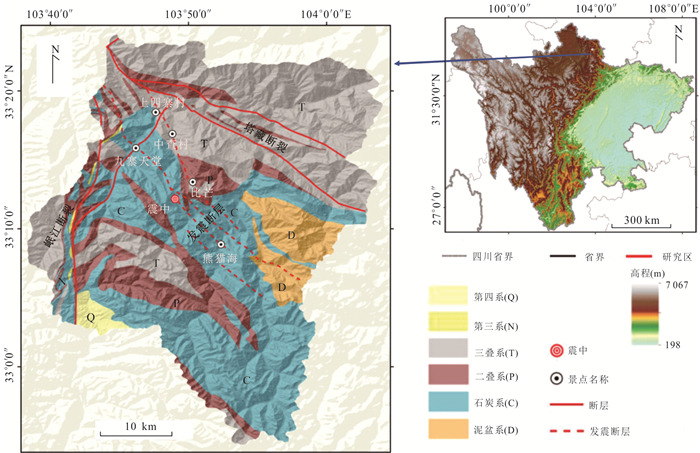
 下载:
下载:
